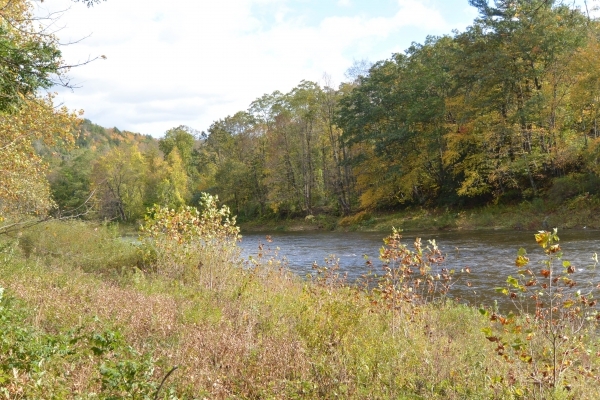BRATTLEBORO — Another piece of Abenaki history has been reclaimed with the creation of the Sibosen Trail.
Pronounced SEE-boo-sehn, which is Abenaki for “river stone,” the trail runs along the West River in what's known as the Riverstone Preserve, 21 acres of land owned by the Friends of the West River Trail that also includes 2,240 feet of shoreline.
The new trail takes a short loop off the main West River Trail and skirts the river's edge.
With the installation of 21 informational signs, many of which include Abenaki language translations, the trail is now complete. That milestone was celebrated on Oct. 17 with a walk.(1)
Dummerston forester Lynn Levine did the research for this project and composed the sign posts. Rich Holschuh, cultural researcher, provided information on the Sokoki, the band of Abenaki from the middle and upper Connecticut River Valley. Dummerston geologist John Warren also provided information.
Brattleboro Town Planner Sue Fillion said that the Vermont Land Trust and the Vermont Housing and Conservation Board helped the Friends purchase the Riverstone Preserve parcel, and the Brattleboro Conservation Commission received a Tiny Grant from the Association of Vermont Conservation Commissions to create an interpretive trail.
Kathleen White, a member of the Friends of the West River Trail, said the inspiration for the Sibosen Trail came during a walk with Levine not long after the Friends secured the Riverstone parcel in 2013.
White said they were walking down a footpath that led to the river and the idea came to her and Levine that “this would make a great trail.”
Levine said the West River was “so important to the Abenaki,” and that tribal representatives “were excited to be a part of this.”
A rich history
According to Holschuh's research, the West River is known as Wantastekw (“at the river where something is lost”) by the Sokoki Abenaki, whose people have been living along its shores for more than 12,000 years.
The river was a main travel route between the Connecticut River and Lake Champlain (Bitawbakw) that was traversed by canoe and on foot.
On many of the signs posted along the trail, a QR code can work with cameras on hikers' smart phones to access the voice of Holschuh, who pronounces the Abenaki translations on the signs.
The signs highlight the trees and vegetation found along the West River, and how the Abenaki made use of them. They also explain the geological history of the West River Valley.
Some of the signs include poems by Levine about the various trees. One tree on the trail is completely encircled by an Oriental Bittersweet vine, an invasive species common to Vermont's woodlands.
Levine writes: “The bittersweet vine/Spirals around a tree/After a while you don't know/Which is which/They look like lovers/But the vine makes the fire/That smothers the tree.”
White said the Friends have had frequent work parties along the trail to clear the invasive plants to give the native species room to grow - or, as she called it, “weeding the woods.”
American beech, white pine, red oak, black cherry, black locust, bigtooth aspen, bitternut hickory, white and black birches, musclewood, and striped maple are among the trees highlighted on the trail.
Levine, who has had a hand in constructing several hiking trails in the Brattleboro area, said her goal has always been “to connect people with the forest.” She says she is quite proud of how this trail turned out and of the many people involved to make it happen.
“This is a wonderful new community resource,” she said.
